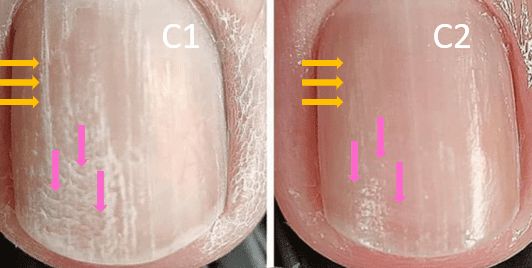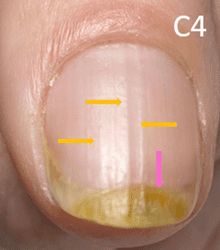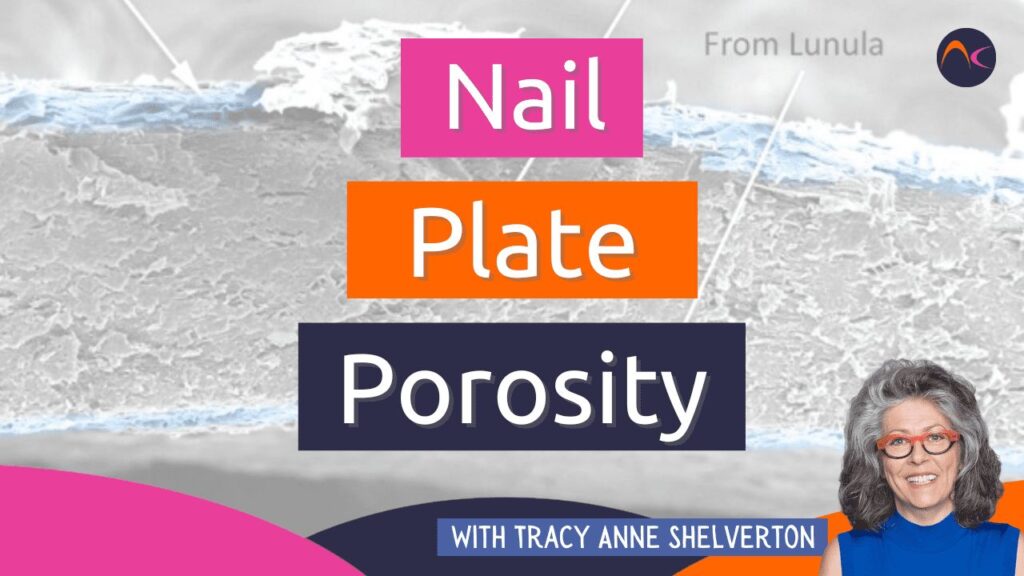Una de las características que marca una gran diferencia en la forma en que los productos reaccionan con la uña, pero de la que no se habla a menudo, es la porosidad de la placa ungueal.
We know that the nail plate is made up of nail plate cells, linked together by desmosomes & anchor knots.
These nail plate cells can be split into 3 groups: about 10% are made by the dorsal matrix, around 80% from the ventral matrix, and about 10% from the distal matrix or lunula.

If all is well, all these different nail plate cells are bound together in such a way that we don’t even notice they are different. Our nail plates look smooth & are strong. They can withstand almost all artificial nail products if we, as nail professionals, take good care not to damage them during or after product application or removal.

The problem begins when changes happen either in the production of nail plate cells or when they are being transported along the eponychium on their journey under the proximal nail fold or the desmosomes & anchor knots are defective.
Let’s have a look at Excessive Porosity.
What does ‘porous’ mean?
According to the Oxford Dictionary, porous means: “Having minute interstices (a very small space) through which liquid or air may pass”.
Nuestras placas ungueales son porosas cuando se encuentran en un estado normal o saludable. Pero no para todos los fluidos. Por ejemplo, una molécula de agua puede atravesar la placa ungueal.
We see this if we have just had a long bath or been in the pool for a while. Our nail plates swell and become really flexible. Think of it as if our nail plates are a natural sponge. In a normal dry state, it is strong and doesn’t bend very well. But if we put that natural sponge in a bucket of water, we can squeeze it and bend it. That’s the bendy nail plate that we experience. Sometimes, this can even help us take care of excessively thick nail plates but… The water soon evaporates, and our nail plates return to their normal size and hardness. If the placa para clavos cells are normal and well taken care of (oil maintenance), we don’t notice it.
But …
If our nail plate cells are not being produced as they should be, we might see a nail plate that looks like this ‘Open beaded ridge’ nail plate.
Si nos fijamos en la placa de la uña A

The upper surface of the nail plate looks shiny & intact, but the nail plate looks like it has ‘little beads’ on the surface, hence the name. The surface of the nail plate is still intact – the light reflects off it, it has ridges, but they are closed and intact, the surface is strong.
Si vamos a elegir un producto de uñas artificiales para esta placa de la uña, queremos utilizar:
1. A product that soaks off well, with a well-known nail treatment in the nail plate first or
2. A more permanent product like L&P or Acrygel.
Why? Because if we start scraping at the top of the groves with our cuticle pusher then we will tear up the nail plate & cause even more problems. Plus, without proper nail plate maintenance with a good quality oil, we might even create a breading space for White Superficial Onychomycosis which is what happened here.

Si nos fijamos en la placa de la uña B

‘Open Beaded Ridge’ nail plate (yellow arrows) & hang nail (blue arrow), with normal growth (remember on average a nail plate grows 1mm a week). Where the nail plate is younger & under the least amount of pressure from the lateral nail folds (green arrows),the nail is smoother. The nail plate cells towards the free edge are much older, so they cannot keep up with the wear & tear of daily nail life.
Este la placa de la uña tiene ranuras, like nail plate A, and a similar beaded effect, but the beads are unraveled, hence the name ‘open beaded ridge nail plate’. These nail plates are a nail technicians’ worst nightmare. Now we need an artificial nail product that adheres to the nail so well that the open ridges won’t cause a problem. The products with the best adhesion usually contain the most aggressive allergens so proceed with caution. Most standard nail products will not adhere to this nail plate for the normal amount of time. Even using a well-known product that we bring into the nail plate, it is on its own, not enough to get these nail plates under control.
Let’s put the 3 different nail plates together:

Let’s get back to porous & why it’s important to recognize it.
The first nail plate (healthy) will absorb any solvent, and that solvent will evaporate without any problems at all.
Porosity of a nail plate happens because, as we get older, the cells get larger, and they start to function abnormally. Nail plate cells become larger, less compact. This causes rifts in the nail plate structure. Additionally, as we age, the nail matrix loses its collagen, and therefore we experience loss of elasticity to the nail. During our daily lives, washing our hair, taking a shower, swimming etc., our nail plates expand and contract. They are also in perpetual motion 24/7. So, these larger cells that are weaker start to rip apart. You can see this in the nail plate of photo B.
Placa ungueal A: Absorberá cualquier disolvente y se hinchará. Esto puede causar un problema durante la retirada del producto. En cualquier caso, si nos pasamos un poco con el empujador de cutículas, podemos crear aún más problemas. Cuando la placa de la uña vuelve a su estado seco original, aparecen pequeñas grietas.
Placa de la uña B: Absorberá cualquier disolvente haciendo que la placa de la uña se hinche. Cuando el disolvente se evapora, las perlas se desgarran un poco más. Cuando la placa de la uña vuelve a su estado seco original, aparecen pequeñas grietas y el estado de la placa de la uña empeora.
Nail Plate C3: Will absorb any solvent, including water, hold it longer than a non-porous nail plate & assist pseudomonas aeruginosa in its development in the nail plate itself. Pseudomonas loves warm, humid, dark spaces. (eg. underneath your artificial nail coating)
Nail plate C: Will absorb any solvent, including water, hold it longer than a non-porous nail plate. If your client is susceptible to White Superficial Onychomycosis, then it will happily develop. It too loves warm, humid, dark spaces. (eg. underneath your artificial nail coating)
Pero hay más:
If we ignore the condition of the nail plate and we don’t improve it before application another problem is waiting for us.

C2: Recuperación de la placa de la uña antes de la aplicación de la placa de la uña artificial con un producto que traemos EN la placa de la uña.
Pseudomonas aeruginosa

Photo C3 shows the Beaded Ridges really well. Per definition, these are more porous nail plates but now with the added bonus of a bacterial infection. Pseudomonas Aeruginosa loves porous nail plates that are not properly maintained with a good quality oil & lotion.
Underneath your artificial nail product, with the help of porous nail plates, pseudomonas can cause havoc. Recovery can take a really long time. This salon clients’ nails grew just 7mm in 7 months!
En situaciones especiales, puede ser necesario retirar la placa ungueal (lo que nunca es bueno, y algo que sólo hacemos con las uñas de las manos), si así lo solicita un médico. Esto es muy poco frecuente, pero podría darse el caso de que, por ejemplo, el cliente vaya a someterse a quimioterapia. En tal caso, las pseudomonas son potencialmente mortales y deben tratarse antes de que comience la terapia.
Como consejo de primeros auxilios
Puedes aconsejar a tu clienta que se lave las manos con agua y jabón y, a continuación, se enjuague las uñas con una solución de vinagre y agua (mezclados en una proporción de 1:1). A continuación, séquelas bien y aplíqueles un aceite de buena calidad. De este modo, el entorno vital que tanto le gusta a la pseudomona cambia a uno en el que ya no puede vivir felizmente. No olvides consultar a tu médico de cabecera para evitar complicaciones.

Artificial nail product manufacturers create products to give us service longevity. That is better for our salons and for our clients. However, it is our job as nail professionals to realize that a product that may suit a perfect nail plate that’s not porous is not the product that we need for nail plate A, for example. And it is definitely not the product for nail plate B!
Looking at the condition of the nail plates of our clients BEFORE we agree to a service is important. Just as important, if not more so, it is important to measure the growth of your client’s nail plate. That way you can:
A: Plan the new appointment at the right time for your clients’ nails, not her wallet.
B: You won’t promise amazing results in a couple of weeks because some nail plates just don’t move at the rate of 1mm a week!
Porous nail plates need constant maintenance, oil, hand washing with soap & water, more oil, and maybe some lotion. More important than that, we need to bring porous nail plates up to optimal condition BEFORE we apply artificial nail product! We also need to apply the right nail product to and for the nail plate in front of us, not the product we have on the shelves. Additionally, our clients need to be aware of the value of nail unit maintenance with oil and lotion.
Una lámina ungueal porosa y sin productos artificiales rara vez sufrirá algún tipo de infección, fúngica o bacteriana.


